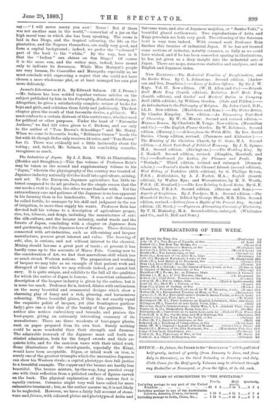The Industries of Japan. By J. J. Rein. With 44
Mustrations. (Hodder and Stoughton.)—This fine volume of Professor Rein's may be taken as the second and supplementary volume to his "Japan," wherein the physiography of the country was treated of. Japanese industry naturally divides itself into agriculture, mining, and art. To the European, Japanese agriculture has little in- terest compared to its art products, for the simple reason that the one needs a visit to Japan, the other we are familiar with. Yet the extraordinary care and patience of the Japanese is no less apparent in his farming than in his handicrafts. With a soil that cannot be called fertile, he manages by his skill and judgment in the use of irrigation, to more than supply his wants. Professor Rein has devoted half his volume to a description of agriculture proper, rice, tea, tobacco, and drugs, including the manufacture of sake, the silk-culture, and the lacquer industry, useful woods and the forests of Japan, concluding with a chapter on Japanese flora and gardening, and the Japanese love of Nature. Those divisions connected with art-industries, such as silk-raising and lacquer manufacture, possess great interest and value. The brewing of sake, also, is curious, and not without interest to the chemist. Mining should become a great part of trade ; at present it has hardly come up to the accounts of Marco Polo. Coming now to the consideration of Art, we find that marvellous skill which has so much struck Western nations. The preparation and working of lacquer we may take as an example of that patient work and disregard of time which we may ridicule indeed, yet cannot but envy. It is quite unique, and exhibits to the full all the qualities for which the native of Japan is famous. A somewhat exhaustive description of the lacquer industry is given by the author, but it is none too much. Professor Rein, indeed, dilates with enthusiasm on the many beautiful and ornamental designs which show a charming play of fancy and a rich, pleasing, and harmonious colouring. Three beautiful plates, if they do not exactly equal the exquisite polish of lacquer, yet (the frontispiece particu- larly) give one a fair idea of the beauty of the patterns. The author also notices embroidery and brocade, and praises the bast-paper, giving an extremely interesting summary of its manufacture. There are three woodcuts of bast-paper plants, each on paper prepared from its own bast. Surely nothing could be more wonderful than their strength and fineness. The admirable ironwork of the Japanese must call forth un- stinted admiration, both for the forged swords and their ex- quisite hilts, and for the cast-iron vases with their inlaid work. Some illustrations of the sword-guards, especially the Kinai, would have been acceptable. &Van, or inlaid work on iron, is surely one of the greatest triumphs which the uncreative Japanese can show his Western rivals ; a capital phototype does full justice to a beautiful example. The copper and the bronze are hardly less beautiful. The bronze mirrors, by-the-way, long puzzled every one with their reflection from a polished surface of figures carved on_the back_ The physical explanation of this curious fact is equally curious. Ceramics might very well have called for more exhaustive treatment ; but, as the author assures us, it is not likely to be neglected. However, we have a fairly full account of stone- ware and faience, with coloured plates and phototypes of Arita and
Satsuma ware, and also of Japanese majolica, or " Banko-Yaki," a beautiful glazed earthenware. Two reproductions of Arita and gaga porcelain are both very good. The colouring of the Satsuma bowl is very true indeed. With enamel work Professor Rein finishes this treatise of industrial Japan. If he has not treated some sections of industry, notably ceramics, as fully as wo could have wished, and if he has been somewhat sparing in illustrations, he has yet given us a deep insight into the industrial arts of Japan. There are maps, numerous statistics and analyses, and an English and Japanese index.


































 Previous page
Previous page